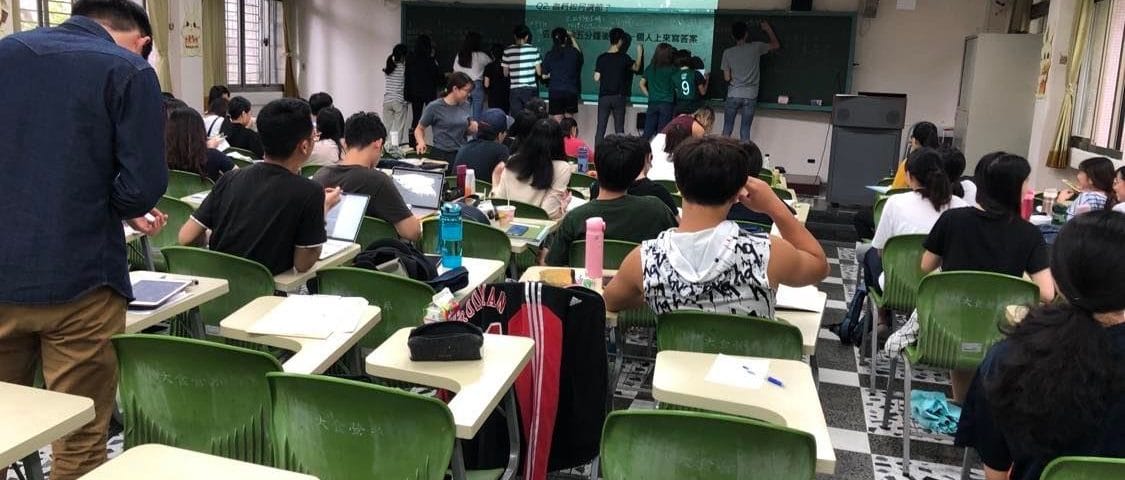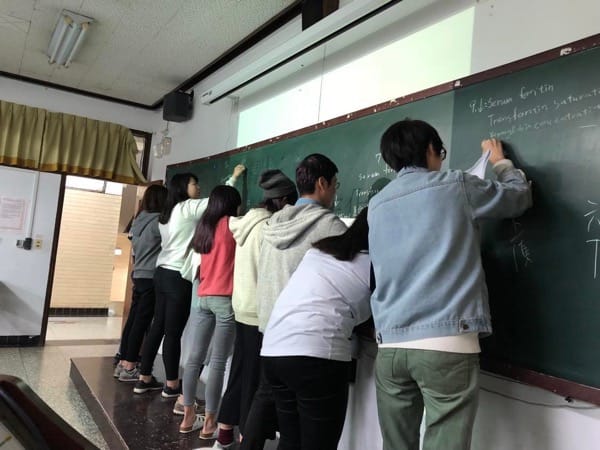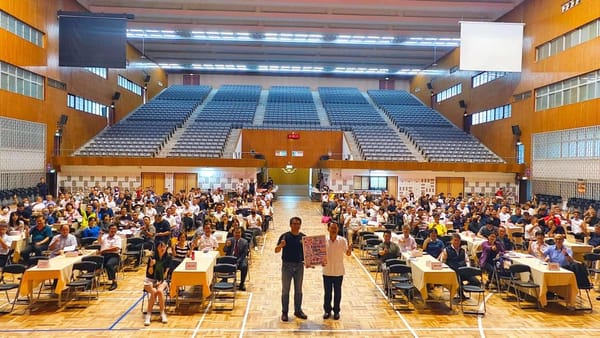Dietitian Civil Service Examination Classroom and Gamification

In my previous explanation of gamifying teaching through competition rules, I used my typical one-day teaching version in a listed company as an example. However, when it comes to a whole semester course spanning 18 weeks in a school setting, how should it be approached? In fact, the pace of an entire semester's curriculum is an ideal time to implement teaching gamification. It allows for a well-organized and systematic execution of each step in the gamification process.
Now, let's dive into how professsor Liu, a renowned nutritionist and the author of a bestselling book, applies gamification to a relatively dull subject of the civil service examination in a university setting throughout an academic year (both semesters). Through this example, we can explore how she transforms the learning experience into a gamified process, focusing on one of the key elements of teaching gamification: establishing game rules.
Stay tuned to discover professsor Liu innovative approach and learn about the crucial aspects of teaching gamification. Together, we'll delve into the fascinating realm of gamified education and uncover the potential it holds for effective and engaging learning experiences.

Week 1: Establishing Rules
The concept of rules revolves around how the upcoming course will unfold and how gamification can be integrated into teaching. During the first week of the university course, it is customary to explain the course outline. Professor Liu took this opportunity to not only outline the teaching content for the semester but also discussed the grading criteria. The final exam would account for 60% of the students' grades, while their performance in class would contribute to the remaining 40%. But how would this class performance be evaluated? This is where gamification comes into play.
Now, let's dive into how professsor Liu, a renowned nutritionist and the author of a bestselling book, applies gamification to a relatively dull subject of the civil service examination in a university setting throughout an academic year (both semesters). Through this example, we can explore how she transforms the learning experience into a gamified process, focusing on one of the key elements of teaching gamification: establishing game rules.
In the first week of class, professsor Liu would announce the following rules:
- The course for this semester will be conducted in small groups, with each group consisting of 5 to 8 students (approximately 6 to 10 groups per class). The grouping will be either randomized by the teacher or self-selected by the students, with the teacher then assigning any remaining students to groups.
- Various activities, including Q&A, discussions, presentations, and data research, will take place during the course. Students will earn points by raising their hands and participating, regardless of whether their answers are correct or not. Additionally, extra points will be awarded for correct answers. Volunteering to go on stage for presentations will also earn the group extra points.
- The teacher will keep a running tally of each group's score on the blackboard, and students can see their accumulated points in real-time. Class monitors will record and announce the weekly rankings of each group.
- The final class performance will primarily be based on the rankings of each group. The top 3 groups should achieve a minimum score of 35 out of 40, the 4th to 6th ranked groups should score 30 or above, the third interval should score 25 or above, and the fourth interval should score 20 or above.
- In addition to the group score, individual performance within the group will also be taken into account. The teacher will observe and consult with the group leader and members for assessment adjustments.
These rules will be explained thoroughly in written form and displayed on slides (distributed to students or captured visually). It can be summarized as: Your performance in class this semester will be linked to your grades!

After Week 2: Course Progression
Once the rules are established, the subsequent progression of regular classes becomes relatively straightforward. The second week, which marks the first official day of class, is crucial. Prior to the class, professsor Liu will remind everyone that there will be some Q&A and discussions during certain sections of the teaching. It is important to remember that participation and performance in these activities will directly impact the group grades. With that, the class can commence.
When reaching a natural break in the teaching, deliberately pause and announce, "Alright, it's Q&A time. Raise your hand and answer, regardless of whether your answer is right or wrong, you will earn points. And if your answer is correct, you'll receive additional points. So, regarding what we just discussed..." Proceed to ask some Q&A questions based on the recent teaching material. It could be a closed-book or open-book approach. This way, the content that was just taught can be immediately reviewed, reinforcing the students' understanding.
Beyond Q&A, additional variations in teaching techniques can be introduced, such as group discussions (comprehensive discussions), asking students to research and answer questions on upcoming topics (preparatory reading within the course), or presenting scenarios that combine real-life examples with the knowledge from the textbook. Teachers are likely familiar with the different approaches to crafting questions. After teaching a section, pause for a review session, using various teaching methods to stimulate students' thinking and enhance their understanding. This approach undoubtedly has a positive impact on learning outcomes.
Furthermore, before each weekly class, the part for hand-raising and answering questions can be designed to recap what was learned the previous week. This not only activates prior knowledge but also helps students prepare for the upcoming week's learning. Through gamification techniques, it quickly directs students' focus into the classroom. Similarly, a similar Q&A review can be conducted before the class ends, allowing students to reflect on their learning in that particular session. Multiple reviews like these greatly aid in reinforcing students' memory.
Unforeseen Effects
Through an interview with professsor Liu, it was revealed that the original course, being a specialized subject for national exams, consisted of a significant amount of memorization and had the pressure of keeping up with the pace. Consequently, the previous class format tended to be lecture-based, making the classroom atmosphere somewhat dull.
However, when introducing gamification into the curriculum and linking the performance of the group teams with their regular grades through the established rules, there was a noticeable increase in student engagement and attentiveness. Q&A sessions and discussions in class were no longer met with silence after posing a question; instead, when the teacher asked a question, students eagerly raised their hands to answer! After all, every participation earned them points, and the more guesses they made, the more opportunities they had! In topics that required book referencing, it was observed that students would remain quiet, flipping through their books, and as soon as the time was up, numerous hands shot up in the air. This level of active participation was not often seen in traditional university classrooms!
Of course, there were still some students who, regardless of gamification, remained their usual "quiet" selves. To encourage participation, professsor Liu sometimes incorporated random selection activities, where students with specific student numbers like 6, 16, 26 would come up to the blackboard! However, if the selected student faced difficulty, other team members were allowed to provide assistance. This ensured that every student in the class had an opportunity to participate.
What was even more interesting were the unforeseen effects! Some students who may have had lower grades or struggled with presentations or memorization found their place to contribute in the gamified teaching process. For example, they might take charge of raising their team's hand to earn points or play the role of discussion paper holder during presentations, or even become the main presenter themselves. As the game revolved around team rather than individual rankings, it actually motivated individuals to perform better. Their efforts were no longer solely for their own benefit but for the overall performance of the team, leading to subtle shifts in the class's participation dynamics. This was a transformation that Professor Liu hadn't initially anticipated.

Conclusion
If we can transform a dull national exam course into an engaging gamified teaching experience, then based on professor Liu's gamified classroom experience, we should question whether the limitations we impose on gamifying our curriculum are genuine constraints or self-imposed limitations.
However, the most important factor is not whether the course is fun or whether students participate but rather the learning outcomes of the students. At least, with the gamification drive, the students' level of focus has increased, and the participatory review at each stage of the course, as well as proactive previewing, have greatly enhanced the learning outcomes.
All of this begins with a fundamental key: establishing the rules for gamifying the curriculum! Taking Professor Liu's example, we can observe three basic rules:
1. Linking class participation with regular grades (gamified reward, "Benefit")
2. Team-based scoring with weekly rankings (gamified points, "Points," and leaderboard, "L," as well as team-oriented competition)
3. Many interactive discussions throughout the course where any participation earns points, and correct answers are rewarded with higher scores (linking instructional format with gamification and creating a risk-free environment)
Of course, behind these exciting teaching methods, a significant amount of preparation time is required! If only textbook content is delivered, the pre-class preparation is relatively straightforward. However, to make the course more engaging, Professor Liu must transform a lot of subject matter expertise and incorporate gamified teaching elements into the entire semester while balancing progress and effectiveness. This means she needs to invest additional preparation time to design the course! Many times, it requires early mornings to prepare and think about the activities for the entire class. However, it is gratifying to see that these efforts yield results. Students are more engaged, focused, and they learn better. The course is no longer solely the teacher's solo performance but a classroom co-constructed by the teacher and students.

After reading this gamified teaching example in a university classroom, has it sparked any different ideas in your mind? I also welcome you to share your thoughts with me! Once again, I would like to express my gratitude to professsor Liu for sharing such an excellent gamified teaching example.
If possible, I also hope that more primary and secondary school teachers can share with me: how do you gamify your classrooms? Feel free to leave a comment or send me a private message. You can also self-recommend or recommend others. Perhaps your classroom will soon appear in A-fu's gamification series of articles or even in a future book!




